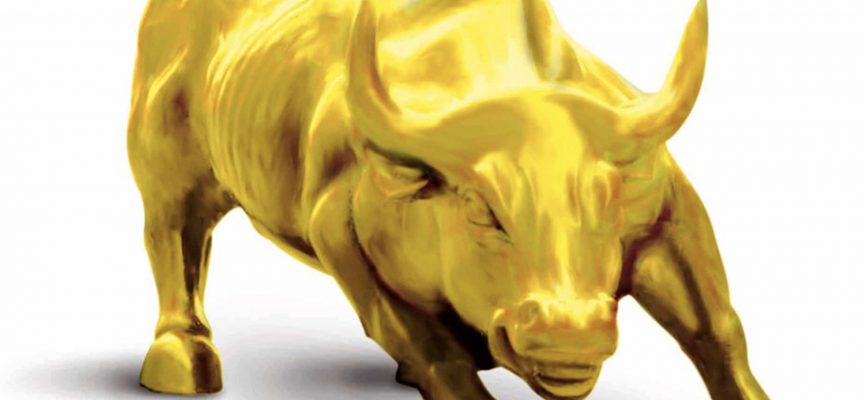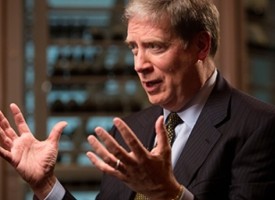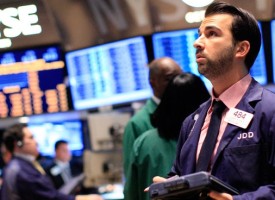With the US Dollar Index trading lower, today a legend in the business told King World News the world is on fire as gold surges and trade wars, currency wars and financial wars heat up.
Gold: Trade Wars, Currency Wars & Financial Wars
By John Ing, Maison Placements
September 17 (King World News) – Amid the politics and symbolism, Mr. Trump has weaponized the US dollar causing it to soar but risks a borrowing shock for half of the world. Once tweeting the dollar is too strong, he now revels in its strength using it as a bully stick to remake the world order. Dollar strength has marked a dividing line between the United States and the rest of the world. In the Sixties, former French President Valery Giscard d’Estaing once complained that the “exorbitant privilege” of the world’s currency allowed the US to borrow more cheaply than it could otherwise, to consume beyond their means and, print money to pay its debts.
That special privilege also allowed the weaponization of the American dollar. In the politics of trade, Mr. Trump has leveraged the dollar’s role to make other nations pay attention to America’s financial hegemony, with the result, relationships with its allies are at a low ebb. Moreover, in using the dollar as his bully stick, he undermines its role as the world’s reserve currency. The stakes could not be higher. Donald Trump has tweeted, “Trade wars are good, and easy to win”. Yet this trade war already has morphed into a currency war, reminiscent of the Dirty Thirties. Financial wars are next. For a time, everyone thought Trump was all tweets and no action. And now equities, commodities and bonds are in danger of becoming collateral damage as the current global financial order changes under Trump and his tweets…
NEW KEITH NEUMEYER INTERVIEW:
Keith Neumeyer just spoke with KWN about $8,000 & $10,000 price targets for gold and much more, to listen immediately CLICK HERE OR ON THE IMAGE BELOW.
 Sponsored
Sponsored
Weaponization of The Dollar
Start with the bull market which has overlooked Trump’s weaponization of tariffs and sanctions. America is not in uncharted territory. The depression in the Thirties morphed into the Great Depression in part by the passage of the Smoot-Hawley Tariff Act, which slapped taxes of 20 percent to 44 percent tariffs on some 900 goods. Within 30 days, 30 countries (including Canada) retaliated and volume dropped by two-thirds exacerbating the Great Depression. Today, Trump’s politically motivated trade war risks a slowing of the global economy, more inflation and other unintended consequences. Already his tariffs sparked a “tit for tat” punitive tariff retaliation on food exports which has hurt a lot of farmers, including Trump’s voting base. Cheap goods won’t be so cheap anymore. US companies, small businesses and ultimately consumers will pay a hefty price for this politicking.
The dollar’s special privilege also allowed the weaponization of sanctions on Iran, which have driven oil prices to the highest levels in four years, spiking global inflation and again squeezing the consumer. Trump’s new sanctions against Russia caused them to dump virtually all their US Treasuries in retaliation and the purchasing of gold at the rate of 25 tonnes a month making Russia today the fifth largest holder at 2,170 tonnes. India too dumped US Treasuries joining China and Japan who are buying gold as a hedge against American financial hegemony. Germany recently joined Russia in looking for alternatives to the American dominated SWIFT bank payment system. The EU itself plans to turn the euro into a global reserve currency that would rival the dollar and reduce its financial dependence on the US. The financial chemistry is changing against the dollar.
And amid this tweetstorm, few notice that Trump’s campaign promise to boost spending on infrastructure and reduce government spending has come and gone. In fact, Mr. Trump is focussing on everything, but the economy, despite controlling both Houses and the White House. As imports flood into the US, the trade deficit has actually widened producing more ammunition for Trump’s trade war, which has boosted an already overvalued dollar. It has happened before. In the past, the US dollar has experienced a series of financial upheavals and was often unreliable as a store of value. In 1985, the United States strong armed France, UK, Germany and Japan to sign the Plaza Accord to weaken the then strong dollar in order to correct trade imbalances. The Asian crisis soon followed. And then, during the Gulf war, President Bush intervened on both sides of the greenback. History shows that currency wars take no prisoners…
Emerging Markets Have Become an Emerging Problem
The strong dollar has tipped the emerging market players into bear market territory as both currencies and growth slowed. India’s rupee, one of the strongest currencies in the emerging markets fell to a record low against the dollar. Argentina was forced to hike rates 60 percent to stop capital flight. Italian yields surged above 3 percent, a level last seen during the money crisis. South Africa’s rand, at one time one of the strongest emerging currencies has fallen to new lows. Indonesia’s rupiah fell to its lowest level since the Asian crisis in 1998 and Brazil’s real has collapsed ahead of an election. Emerging markets have become an emerging problem.
Alarming is that the strong dollar and plunging currencies have crippled the emerging countries’ debt paying ability since many hold cheap US dollar denominated debt and the rising dollar increases the cost of servicing that debt. We believe those collapsing currencies are the first volley in a competitive devaluation war, sparked by Trump’s hardball politics of trade and his “America First” program. Despite earlier preferring a weaker dollar, Mr. Trump recently tweeted, “Money is pouring into our cherished dollar like never before”. Yet he believes China and Europe are manipulating their currencies, making US exports less competitive. This time his tweets are all action…
ALERT:
To see the symbol for the only gold explorer in the world with no debt and a
massive treasury that has seen insiders buy more than 3 million shares
in the open market in the past few months CLICK HERE OR BELOW
Consider Turkey, locked in a standoff with the United States. At yearend, one US dollar was worth 3.79 lira. Today the lira is worth about 6.18, so their debt now costs 63 percent more to repay. In a multi-polar world, investors have dumped emerging market debt on fears that the Turkish and Argentina twin crises could spread to other emerging markets, triggering a currency war. Argentina needed a record breaking $50 billion IMF bailout after raising rates to stop the peso from collapsing further. They are not alone. In the developed world, Italy’s huge debt leaves it vulnerable to economic and political shocks whilst its newly minted government is anti-EU and anti-austerity. Other EU nations including Britain are also vulnerable to a rising dollar because of their outsized dollar denominated indebtedness and need for capital inflows.
Déjà vu
The Dirty Thirties and risk became an object lesson for central bankers. In response to the major financial collapse of 2008, there was a dramatic increase in government sponsored liquidity that included successive rounds of quantitative easing. The IMF calculated between 1987 and 2011, the world suffered through 147 banking crises, including the Lehman collapse only ten years ago when the system was flooded with liquidity to avoid a repeat of the Great Depression. However, former Chairman Bernanke and subsequent Fed chairs have repeated the same mistake of yesteryear in piling up ever higher debt on their balance sheets.
Looking back, there’s no question that the Smoot-Hawley Tariff Act of June 1930 was the catalyst turning the depression into the Great Depression. The tariffs were the largest single tax increase on trade and sparked retaliation by some 30 countries, including Canada. Although the Americans had backed the greenback with gold, panic and a wave of bank runs ensued on fears that the Treasury would run out of gold. In January 1934, the Fed suspended the dollar’s convertibility into gold and gold clauses were subsequently changed with it becoming illegal to hold gold. The government subsequently confiscated gold and raised the price to $35 an ounce which effectively devalued the dollar. A sidebar is that much of the 8,100 tonnes held in Fort Knox today came from that confiscation. The dollar no longer became as good as gold.
Bank deposits are now federally insured but government spending still makes up a large part of the economy. Of course, when Nixon officially took the dollar off the gold standard in 1971, the foundation of the dollar was backed only by fiat and the good faith and credit of the United States. And, just as America displaced Britain as the world’s pre-eminent economic power, today America’s massive debts, escalating tariff wars and increased government spending are flashbacks of that past undermining the dollar’s role as a store of value. Gold’s role however remains the same.
America Needs Foreign Capital to Pay its Bills
Although, the collapse of Turkey was largely self-inflicted, the toxic combination of low interest rates, excessive money creation and massive government spending caused them to rely upon foreigners to finance its growing deficits. Similar too is the United States. Like Turkey, America’s growing debt load is never-ending and set to top $1 trillion every year in each of the next four years. Since the last crisis, debt has not gone away but is higher than ever, limiting the Fed’s ability to buy their way out of trouble. Debt on debt is not good.
Moreover, Trump’s trillion dollar tax cut has driven the deficit to unsustainable levels such that the Americans must rely upon the largesse of foreigners to fund their day to day activities, difficult after slapping allies with tariffs or declaring them national security threats as a pretext to give the United States a better negotiating position. Without outside funding, the United States must rely on printing more money to pay for its debts but in monetizing, will cause a massive depreciation in the dollar. A decade ago the US Treasury market was some $5 trillion. Today, Treasury issuances are over $15 trillion or a 200 percent increase. Given the United State’s dependence on foreign capital, an eroding dollar value would see an avalanche of dollars, and the massive dumping of assets and Treasuries leaving the Fed the buyer of last resort.
We believe, the reality is that like Turkey, the United States has become overly dependent upon foreign financing needing constant inflows. With the upcoming November mid-term elections setting up the prospects of a Democrat-controlled House and gridlock, those overseas funds may not be forthcoming. Trump once complained that a weaker dollar was “killing us”, now revels in the strong dollar because he believes his tariffs are making America great again. How wrong. Instead his Made in America policies have generated an open-ended cycle of protectionism, populism and competitive devaluations, undermining America and the dollar’s influence…
ALERT:
Mining legend Ross Beaty (Chairman Pan American Silver) is investing in a company very few people know about. To find out which company CLICK HERE OR ON THE IMAGE BELOW.
 Sponsored
Sponsored
China vs US
Then there is the escalating economic cold war with China which raises fears of slowing global growth and the “Thucydides Trap”. However, we believe that the brinkmanship is symptomatic of a much deeper rivalry to determine global leadership on the technologies of the future. China remains the world’s workshop. Yet within weeks, a full blown trade war will have started when the US slaps punitive tariffs on virtually all of Chinese imports. China will likely counter putting tariffs on some 80 percent of US exports to China which would be problematic for Mr. Trump since consumer spending accounts for 70 percent of the US economy. Apple products, flat screen TVs and cars are to cost US consumers more. China’s domestic market on the other hand, is growing at twice the rate of America’s and the impact will be less on China’s economy which is growing at a robust 6 percent plus. Although, China’s currency has fallen 10 percent, exports to the rest of the world have picked up. China also used other fiscal tools by pumping up government spending and expanding its big banks’ balance sheets to help offset the impact of tariffs.
However, nobody will win in a war between the world’s two biggest economies. Of more importance is that China has accumulated more than $3 trillion of reserves and is the largest of America’s foreign creditors. China was the major buyer of US dollar debt but its recent absence and currency diversification moves has upset the financial hegemony of the US dollar. America’s vulnerability is that it needs outside capital and in becoming the biggest debtor in the world, will need funding from the biggest creditor in the world.
China is also the world’s largest producer and consumer of gold for both jewelry and investment purposes. China has become the fifth largest gold holder after Russia at 1,842 tonnes. China recently swapped renminbi for oil with Russia and Saudi Arabia as China diversifies away from the dollar and settlement system. China will also import Iranian oil using renminbi. An increasing amount of China’s trade with other countries, particularly those along the One Belt, One Road initiative is now issued and settled in renminbi. Could China someday peg its currency to gold? In time, yes. China’s $3 trillion in reserves give it a claim in the creation of a new or alternate monetary order. After all, the economic locomotive pulling the world is China, not America. China is also the world’s largest trader in physical gold through the Shanghai Gold Exchange (SGE).
Renminbi denominated contracts are a further step in the internationalizing of its currency and diversification away from dollars. Gold is an alternative to the dollar and now with the physical market firmly under Chinese control, the dollar’s days are numbered.
Inflation Is Back
In the meantime, US policies will ultimately lead to weaker growth and higher inflation. Inflation is back. The latest consumer price index (CPI) reported a 3 percent (above the Fed’s 2 percent target) increase suggesting growing wage and price pressures. August payrolls came in stronger than expected. Unemployment is near all time lows. Energy is higher. Food prices jumped as Trump’s tariffs are beginning to take hold. Steel prices alone are up 40 percent. Tariffs are simply inflationary. Inflation is a dynamic animal, once started, it is hard to stop. In the emerging markets, signs of corporate distress and concern over plunging currencies have lifted inflation to double digit levels.
Inflation is harmful to the economy. In the Seventies, after wars and deficit spending, inflation was bordering on virulent and former chairman Paul Volcker needed almost a decade to rein it in. which did trigger the Latin American crisis in the 1980s. This time, fed by rounds of quantitative easing and Trump’s trillion-dollar tax cut, the minuscule central bank increases will not rein in the inflation that Trump’s tariffs have started…
BONUS INTERVIEW:
To listen to Doug Casey’s just-released KWN interview discussing his prediction of financial and economic chaos and a panic into gold CLICK HERE OR BELOW:
World on Fire
Also boosting inflation is climate change. Extreme heat waves have gripped the world. This year may prove to be the hottest year on record according to NASA’s network of satellites, buoys, ships and land status. Climate change has affected major centers from drought to crop yields to hurricanes to fatalities leaving the world with depleted inventories. Trump’s tariffs only exacerbated the trend. Even grain prices have skyrocketed due to crops affected by heat and drought. Last year was a record breaking season for wildfires in the United States. In Europe, nuclear reactors have been shutdown because of the lack of water. This year the planet will record its fourth hottest year, ever.
Some areas of North America are returning to the dustbowl, reminiscent again of the Great Depression when one million acres were affected and thousands of farmers lost their livelihoods and property. During the Great Depression, large areas of the plains were affected by drought and soil erosion, causing starvation and the migration of families, many to California. The phrase “dustbowl” came from a 1935 newspaper account of describing the dust storms that drifted across the prairies in Texas. Weather was undoubtedly a factor, but American farmers also were to blame. Extremes whether hot or cold are not good. Inflation is a dynamic animal.
Has Gold lost its Midas Touch?
Gold has fallen 12 percent, briefly trading below $1,200 an ounce after reaching a peak of $1,358 an ounce earlier this year. To be sure, the stronger dollar and uptick in rates has weakened the appeal of holding gold and the latest data reported that hedge funds and investors have placed a massive gold short bet at levels last seen in 2001, when the funds foolishly shorted gold at $275 an ounce, the bottom of the market. We believe a day of reckoning is around the corner since there is not enough inventory in Comex warehouses to cover this position.

Significantly if measured in Turkish lira, Venezuelan pesos, India’s rupee or Indonesian rupiah, gold has protected wealth as a safe haven. Gold priced in Turkish lira has jumped 70 percent and its trading volume doubled as local prices jumped by a third. Although gold priced in lira has become more expensive, it still heads higher as gold holders hedge against further depreciation. It is not that gold is going down but it is just that gold measured against the dollar has fallen. To be sure in dollar terms, gold have been disappointing. However, since yearend measured in about ten local currencies such as the pound or even the euro, gold has climbed 2 percent while in dollar terms, it is off 6 percent.
Still gold remains an international currency holding its value over time. Importantly, it is a currency not issued by a sovereign nor by fiat. Gold remains part of the international monetary system and held in reserves by the International Monetary Fund, BIS and most central banks. It is the ultimate payment system, immune from US financial sanctions and payment system.
Gold Will Be a Good Thing To Have
The Great Depression was a global economic collapse but was preventable. Today global trade is more important than in the Thirties with supply chains that span the globe. However, Trump’s tariffs will curb global economic growth, which will be disastrous for American exporters and their supply chains. Unlike in the Thirties, there are safety nets today such as Social Security, Medicare and Medicaid but the costs however are in the trillions, hidden in off-balance-sheet items.
And despite holding the world’s biggest debt, America continues to spend more than it produces and today that debt is higher than in 2008, the last financial crisis. US isolationism and deepening geopolitical rifts has seen the trade wars morph into currency wars undermining the dollar as the world’s reserve currency. The US has a serious problem with their deficits and an overvalued dollar. The dollar is on shaky foundations.
America’s Achilles heel is that it is dependent on foreigners to finance its deficits. American privilege remains exorbitant, for now. However, the lesson from the Great Depression is that well-intentioned policies could easily turn a recession into a depression. The background of negative influences for the dollar is also positive for gold. We thus expect a major realignment between gold and the dollar. Gold will be a good thing to have.
Mr. Trump’s staying power lies in this politician’s single–minded effort to tap the zeitgeist that included opening up the fault-lines on immigration and blaming them for “hollowing out” America’s industrial capacity. After a decade of austerity and stagnant incomes, his never-ending political campaigning capitalized on America’s endless wars as part of a nationalistic push at the expense of globalization and immigration. His America First campaign seized on the view that the US is no longer dominant, raising the prospect that the ascendance of China is a “Thucydides Trap”. And of course there were constant tweets of promise and hope of the old days already gone. Mr. Trump was simply the beneficiary of promises lost as voters flocked to his populist message peddling an alternative version of realities. Still, The Donald no longer shocks, which is shocking, almost as shocking is the prospect of four more years. Again, gold will be a good thing to have.
***KWN has now released the powerful and timely KWN audio interview with Andrew Maguire and you can listen to it by CLICKING HERE OR ON THE IMAGE BELOW.
ALSO JUST RELEASED: Greyerz – The Final Collapse Has Already Begun And It Will Engulf The World In Chaos CLICK HERE TO READ.
© 2018 by King World News®. All Rights Reserved. This material may not be published, broadcast, rewritten, or redistributed. However, linking directly to the articles is permitted and encouraged.










